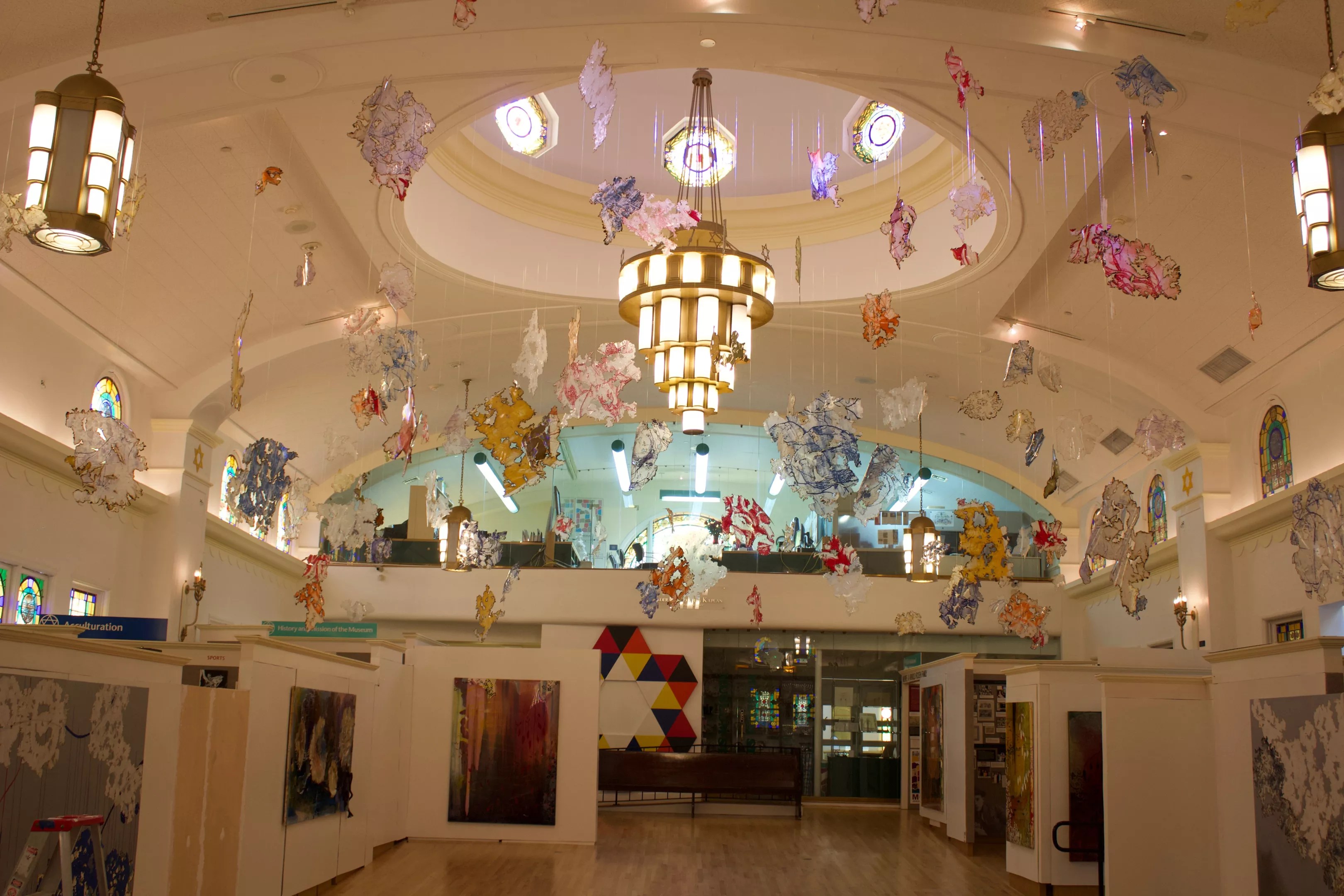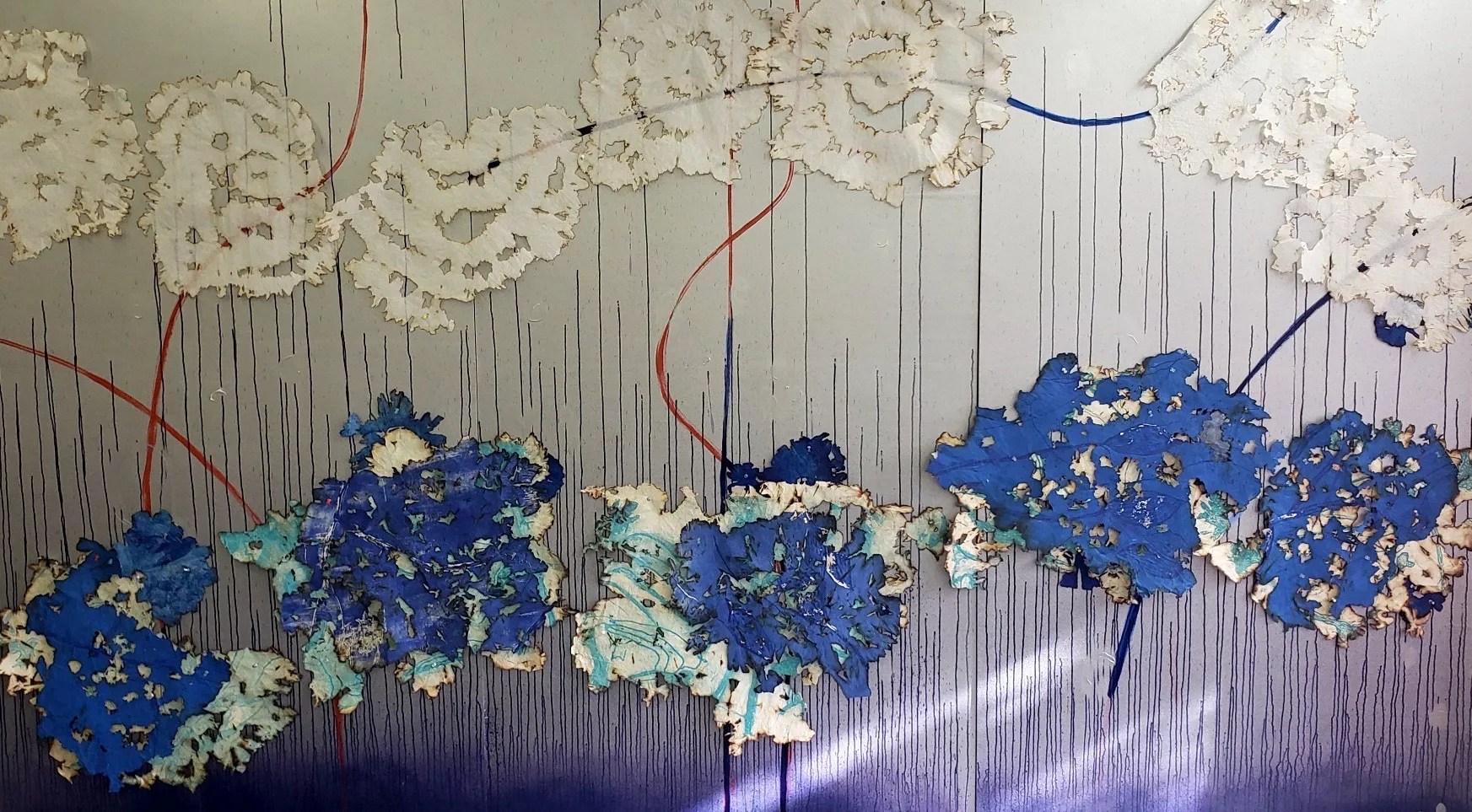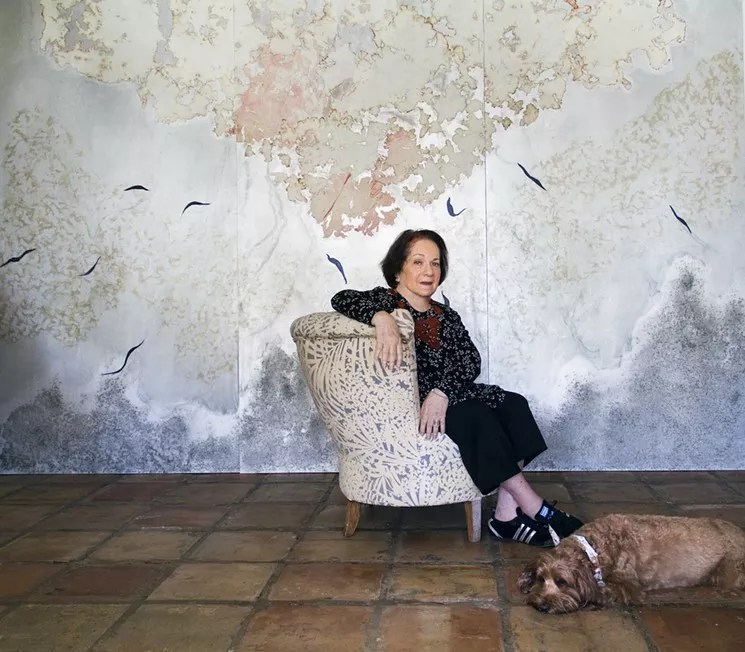
Mira Lehr, Jewish Museum of Florida-FIU

Audio By Carbonatix
Sitting on a bench in the converted synagogue of the Jewish Museum of Florida in South Beach, you might mistake Mira Lehr for a visitor. She could be someone from the neighborhood, just passing by. The only thing that gives her away as an artist is her bright-red necklace, made with the same shards of colored resin hanging from the synagogue ceiling like a giant mobile.
“I think there are 180 of them,” she says of the installation, “and I think I worked for three weeks, almost without sleeping.”
In Mira Lehr: A Walk in the Garden, birdsong wafts through the space while dozens of resin sculptures dance in the air-conditioned breeze. On her canvases, abstract images of flora and fauna made with paint and specialized Japanese paper stock hide behind translucent resin coating. Art aficionados might see the influence of ukiyo-e woodblock prints or the paintings of Cy Twombly. Religious folks can find biblical messages in works such as Path to Jericho and The Seven Species, based on a passage from Deuteronomy. But nature dominates: Looking at a piece by Lehr, such as Sand Bar or Search, is like gazing into a tide pool whose creatures seem alien but are undeniably of this earth.
“I don’t know why I did it,” Lehr says of her use of resin. “I think it was available, and I saw it put some extra dimension on the paintings, because you felt you were looking through a glass almost. And it protected them – I may have started because I was protecting paper things I did.”
Miami, make your New Year’s Resolution Count!
We’re $14,000 away from reaching our $30,000 year-end fundraising goal. Your support could be what pushes us over the top. If our work has kept you informed, helped you understand a complex issue, or better connected you to your community, please consider making a contribution today.

Dance (2019)
Mira Lehr, Jewish Museum of Florida-FIU
Lehr is 85 now – old enough to remember when the museum was still a working temple and when Jewish people were less than welcome in Miami Beach. When her family moved from 12th Street to 41st – where there was no significant Jewish population at the time – she passed daily an apartment building with a sign reading, “No Jews, No Dogs.” Her first day at North Beach Elementary School, when she told a classmate she was Jewish, her peer replied, “Oh, my God, another one!”
She faced similar struggles when she applied to college but eventually found her place at Vassar. “I think in a class of 400, there might’ve been two or three Jews,” she recalls. The all-women college nevertheless instilled a strong sense of feminism in her – “We were running the school,” she says – which she would need in the thriving yet chauvinistic New York art scene of the ’50s, where great women artists were considered “hobbyists.”
“But that’s where abstract expressionism was, and that was the movement of the day,” she says. “And I was right in the midst of it.”
Lehr lived it up while in New York, keeping a studio in Carnegie Hall and studying with the Hans Hofman circle. She got to know the likes of Helen Frankenthaler and Robert Motherwell. She recalls a time at the now-legendary Cedar Tavern when Joan Mitchell (“She had the filthiest mouth I think I’ve ever heard”) crushed a man’s testicles after he groped her breasts, causing him to shriek in pain. “Nobody ever bothered her like that again.”
In 1960, Lehr’s husband, a cardiologist, accepted a job in Miami Beach, and the couple left New York. She continued to work but had to raise her two children in a repressive social climate – local women were scandalized when they learned Lehr’s husband, instead of Lehr, took their kids to school.
Her relocation was made all the more difficult by the absence of an art scene. She and a group of other artistically minded women founded a gallery, Continuum, that pioneered art in Miami and lasted into the ’90s. The members worked together and Lehr used her connections to bring to town high-profile teachers such as Betty Parsons and R. Buckminster Fuller – “Bucky,” as Lehr calls him – who eventually recruited Lehr for his World Game series in 1969.
“We were the only show in town, and Miami Beach was a vacuum of culture then,” she relates.

Mira Lehr sits in front of Creation (2016). The 85-year-old artist’s latest installation is on display at the Jewish Museum of Florida.
Cristina Molina
Nowadays, Lehr’s mind is mostly on the primary subject of her art – the environment. She says she’s thinking of converting her swimming pool into a seahorse sanctuary to help local populations recover from habitat loss. She also points out that one of the ironies of using resin is its potential for environmental harm. Synthetic polymer resin can be highly toxic, and though Lehr is careful to source a safer, albeit more expensive, form of resin for her work, she would prefer to find an alternative. Two of her newest works on display – a pair of triptychs that resemble Japanese painted screens – eschew the material.
She’s also “terrified” of climate change. One recent work at the Museum of Contemporary Art North Miami, Tracing the Red Thread, envisions the climate crisis as a mangrove forest. Inspired by the labyrinth of Greek myth, a fateful red thread leads viewers out of the maze. It’s an oddly hopeful message, but coming from someone who’s experienced plenty of darkness in her life, it’s all the more resonant.
“I just believe we’re capable of so much and man is our best resource. And in the midst of terrible things, man usually comes up with something that reverses the terrible situation. But in this case, I’m worried if we go too far, we won’t be able to.”
Mira Lehr: A Walk in the Garden. Through February 3, 2020, at the Jewish Museum of Florida-FIU, 301 Washington Ave., Miami Beach; 305-672-5044; jmof.fiu.org. Admission costs $24 Sunday through Friday and is free Saturday.